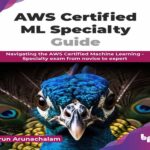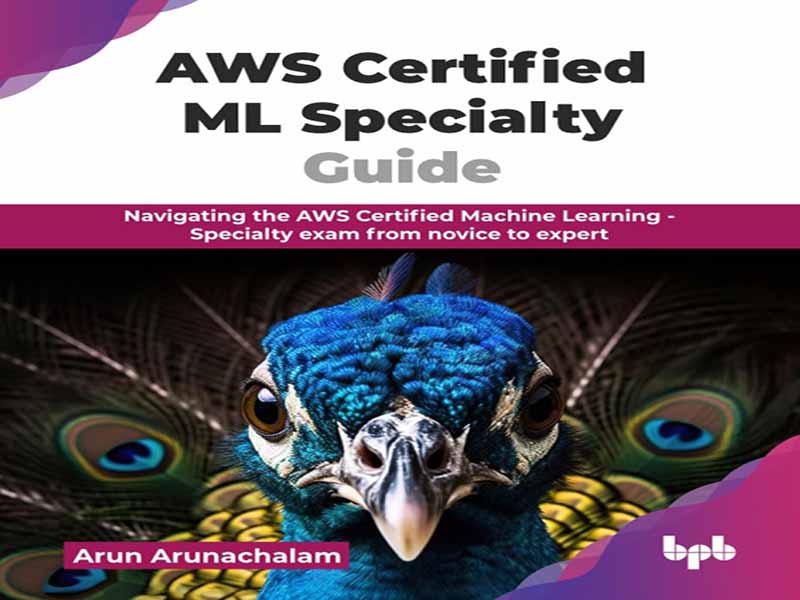- عنوان کتاب: AWS Certified ML Specialty Guide
- نویسنده: Arun Arunachalam
- حوزه: یادگیری ماشین
- سال انتشار: 2026
- تعداد صفحه: 550
- زبان اصلی: انگلیسی
- نوع فایل: pdf
- حجم فایل: 4.16 مگابایت
انقلاب یادگیری ماشینی، صنایع سراسر جهان را متحول میکند، درست مانند ظهور برق. از آنجایی که سازمانها به طور فزایندهای به بینشهای مبتنی بر داده و اتوماسیون هوشمند متکی هستند، تقاضا برای متخصصان ماهر یادگیری ماشینی که میتوانند از قدرت محاسبات ابری بهره ببرند، هرگز به این اندازه زیاد نبوده است. خدمات وب آمازون به عنوان پلتفرم پیشرو برای ساخت، استقرار و مدیریت راهحلهای یادگیری ماشینی در مقیاس بزرگ ظهور کرده است. این کتاب به عنوان راهنمای جامع شما برای تسلط بر یادگیری ماشینی در AWS و قبولی موفقیتآمیز در آزمون تخصصی یادگیری ماشینی معتبر AWS طراحی شده است. این کتاب شکاف بین دانش بنیادی محاسبات ابری و تخصص پیشرفته یادگیری ماشینی را پر میکند و شما را به سفری از درک مفاهیم اولیه تا ساخت راهحلهای ML آماده برای تولید میبرد. در طول این راهنما، شما تجربه عملی با سرویسهای ضروری AWS، از جمله Amazon SageMaker، AWS Glue، Amazon Kinesis، AWS Lambda و بسیاری دیگر، کسب خواهید کرد. این کتاب حول چهار حوزه کلیدی گواهینامه تخصصی AWS ML، یعنی مهندسی داده، تجزیه و تحلیل اکتشافی دادهها، مدلسازی و پیادهسازی و عملیات یادگیری ماشینی، ساختار یافته است. هر فصل بر اساس مفاهیم قبلی بنا شده و در عین حال مثالهای عملی و دنیای واقعی را ارائه میدهد که میتوانید بلافاصله از آنها استفاده کنید. این کتاب برای متخصصان مشتاق یادگیری ماشین، دانشمندان داده، مهندسان داده، معماران ابری و متخصصانی که به دنبال اعتبارسنجی تخصص خود در فناوریهای یادگیری ماشین AWS هستند، در نظر گرفته شده است. چه در حال شروع سفر یادگیری ماشین خود باشید و چه به دنبال رسمی کردن دانش موجود خود، این راهنما شما را با مهارتها و اعتماد به نفس لازم برای برتری در زمینه به سرعت در حال تحول یادگیری ماشین مبتنی بر ابر مجهز میکند. با این کتاب، شما نه تنها برای موفقیت در صدور گواهینامه آماده میشوید، بلکه مهارتهای عملی لازم برای پیشبرد نوآوری و ایجاد تأثیر معنادار در سازمان خود را از طریق قدرت یادگیری ماشین AWS توسعه میدهید. فصل 1: ایجاد مخازن داده برای یادگیری ماشین – این فصل با بررسی چگونگی شناسایی منابع داده متنوع و انتخاب راهحلهای ذخیرهسازی مناسب در AWS، پایه و اساس هر پروژه ML را بنا میکند. این فصل پایگاههای داده، Amazon S3، Amazon EFS و Amazon EBS را پوشش میدهد و بهترین شیوهها را برای طراحی مخزن داده و استراتژیهای ادغام ارائه میدهد که تضمین میکند زیرساخت داده شما میتواند از گردشهای کاری قوی یادگیری ماشین از پردازش دستهای ساده تا تجزیه و تحلیلهای پیچیده در زمان واقعی پشتیبانی کند. فصل 2: پیادهسازی راهکارهای جذب داده – این فصل فرآیند حیاتی انتقال دادهها به خط لوله یادگیری ماشین شما را مورد بحث قرار میدهد و الگوهای جذب دادههای دستهای و جریانی را پوشش میدهد. شما یاد خواهید گرفت که از Amazon Kinesis، Amazon EMR، AWS Glue و سایر سرویسهای AWS برای هماهنگسازی و خودکارسازی خطوط لوله داده، از جمله زمانبندی و مدیریت کارهای پیچیده جذب داده برای انواع و حجمهای مختلف داده در نیازهای مختلف سازمانی، استفاده کنید. فصل 3: تبدیل دادهها به بینشها – این فصل بر تبدیل دادههای خام به فرمتهای مناسب برای تجزیه و تحلیل یادگیری ماشین تمرکز دارد. این فصل فرآیندهای ETL را با استفاده از AWS Glue و Amazon EMR بررسی میکند، تبدیل دادههای خاص یادگیری ماشین را با MapReduce، Apache Hadoop، Spark و Hive مدیریت میکند، در حالی که تکنیکهای بهینهسازی را برای آمادهسازی دادهها برای الگوریتمهای مختلف یادگیری ماشین و تضمین گردشهای کاری تبدیل مقیاسپذیر ارائه میدهد. فصل 4: پاکسازی و آمادهسازی دادهها – این فصل به وظیفه حیاتی تضمین کیفیت دادهها و آمادگی برای مدلسازی میپردازد. شما یاد خواهید گرفت که دادههای گمشده یا خراب را شناسایی و مدیریت کنید، تکنیکهای پاکسازی و پیشپردازش دادهها را پیادهسازی کنید و روشهای نرمالسازی و مقیاسبندی را اعمال کنید. این فصل بر استراتژیهای افزایش داده و شیوههای ارزیابی کیفیت که برای نتایج موفقیتآمیز یادگیری ماشین ضروری هستند، ضمن حفظ یکپارچگی دادهها در طول فرآیند آمادهسازی، تأکید میکند. فصل 5: مهندسی ویژگی – این فصل به بررسی هنر و علم استخراج ویژگیهای معنادار از منابع داده متنوع از جمله متن، گفتار و تصاویر میپردازد. این فصل تکنیکهای شناسایی ویژگی، روشهای کاهش ابعاد و رویکردهای تبدیل ویژگی را پوشش میدهد، با مثالهای عملی که نحوه افزایش مجموعه دادههای شما را برای عملکرد بهینه مدل یادگیری ماشین با استفاده از ابزارهای AWS مانند فروشگاه ویژگی SageMaker و قابلیتهای پردازش نشان میدهد. فصل 6: تجزیه و تحلیل دادهها و تجسم – این فصل به شما میآموزد که چگونه تجسمهای بینشبخش ایجاد کنید و آمارهای کلیدی را که به تصمیمگیری یادگیری ماشین کمک میکنند، تفسیر کنید. شما یاد خواهید گرفت که انواع مختلف نمودار را تولید کنید، آمار توصیفی را درک کنید، تجزیه و تحلیل خوشهای را برای تقسیمبندی دادهها پیادهسازی کنید و از ابزارهای تجسم AWS از جمله QuickSight برای انتقال مؤثر بینش دادهها به ذینفعان و اعتبارسنجی فرضیات تحلیلی خود استفاده کنید. فصل 7: چارچوببندی مشکلات کسبوکار به عنوان مشکلات یادگیری ماشین – این فصل شکاف بین چالشهای کسبوکار و راهحلهای فنی یادگیری ماشین را پر میکند. این فصل به شما کمک میکند تا ارزیابی کنید که چه زمانی …
The machine learning revolution is transforming industries across the globe, much like the advent of electricity once did. As organizations increasingly rely on data-driven insights and intelligent automation, the demand for skilled machine learning professionals who can harness the power of cloud computing has never been greater. Amazon Web Services has emerged as the leading platform for building, deploying, and managing machine learning solutions at scale. This book is designed to be your comprehensive guide to mastering machine learning on AWS and successfully passing the AWS Certified Machine Learning – Specialty exam. It bridges the gap between fundamental cloud computing knowledge and advanced machine learning expertise, taking you on a journey from understanding basic concepts to building production-ready ML solutions. Throughout this guide, you will gain hands-on experience with essential AWS services, including Amazon SageMaker, AWS Glue, Amazon Kinesis, AWS Lambda, and many others. The book is structured around the four key domains of the AWS ML Specialty certification, that is,data engineering, exploratory data analysis, modeling, and machine learning implementation and operations. Each chapter builds upon previous concepts while providing practical, real-world examples that you can apply immediately. This book is intended for aspiring machine learning specialists, data scientists, data engineers, cloud architects, and professionals seeking to validate their expertise in AWS machine learning technologies. Whether you are beginning your machine learning journey or looking to formalize your existing knowledge, this guide will equip you with the skills and confidence needed to excel in the rapidly evolving field of cloud-based machine learning. With this book, you will not only prepare for certification success but also develop the practical skills necessary to drive innovation and make a meaningful impact in your organization through the power of AWS machine learning. Chapter 1: Creating Data Repositories for Machine Learning- This chapter establishes the foundation for any ML project by exploring how to identify diverse data sources and select appropriate storage solutions on AWS. The chapter covers databases, Amazon S3, Amazon EFS, and Amazon EBS, providing best practices for data repository design and integration strategies that ensure your data infrastructure can support robust machine learning workflows from simple batch processing to complex realtime analytics. Chapter 2: Implementing Data Ingestion Solutions- This chapter discusses the critical process of moving data into your ML pipeline, covering both batch and streaming data ingestion patterns. You wi’ll learn to leverage Amazon Kinesis, Amazon EMR, AWS Glue, and other AWS services to orchestrate and automate data pipelines, including scheduling and managing complex data ingestion jobs for various data types and volumes across different organizational needs. Chapter 3: Transforming Data into Insights– This chapter focuses on converting raw data into formats suitable for machine learning analysis. The chapter explores ETL processes using AWS Glue and Amazon EMR, handling ML-specific data transformations with MapReduce, Apache Hadoop, Spark, and Hive, while providing optimization techniques to prepare data for various ML algorithms and ensuring scalable transformation workflows. Chapter 4: Data Sanitization and Preparation- This chapter addresses the crucial task of ensuring data quality and readiness for modeling. You will learn to identify and handle missing or corrupt data, implement data cleaning and preprocessing techniques, and apply normalization and scaling methods. The chapter emphasizes data augmentation strategies and quality assessment practices essential for successful ML outcomes while maintaining data integrity throughout the preparation process. Chapter 5: Feature Engineering- This chapter explores the art and science of extracting meaningful features from diverse data sources including text, speech, and images. The chapter covers feature identification techniques, dimensionality reduction methods, and feature transformation approaches, with practical examples demonstrating how to enhance your datasets for optimal ML model performance using AWS tools like SageMaker Feature Store and processing capabilities. Chapter 6: Data Analysis and Visualization- This chapter teaches you to create insightful visualizations and interpret key statistics that inform ML decision-making. You will learn to generate various graph types, understand descriptive statistics, implement cluster analysis for data segmentation, and utilize AWS visualization tools including QuickSight to effectively communicate data insights to stakeholders and validate your analytical assumptions. Chapter 7: Framing Business Problems as ML Problems- This chapter bridges the gap between business challenges and technical ML solutions. The chapter helps you assess when ML is appropriate, differentiate between supervised and unsupervised learning approaches, and select suitable models for various business scenarios through real-world case studies and best practices for problem definition, ensuring alignment between business objectives and technical implementation. Chapter 8: Selecting Appropriate ML Models- This chapter provides comprehensive coverage of the ML model landscape, including XGBoost, logistic regression, decision trees, and neural networks such as RNNs and CNNs. You will develop intuition about model selection criteria based on data characteristics and problem types, while learning to leverage AWS tools and SageMaker’s built-in algorithms for effective model implementation and comparison. Chapter 9: Training ML Models- This chapter covers methodologies and best practices for effective model training, including data splitting strategies, optimization techniques, and compute resource selection. The chapter addresses GPU vs CPU considerations, Spark and non-Spark platforms, and provides guidance on updating and retraining strategies to maintain model relevance using SageMaker training jobs and distributed training capabilities. Chapter 10: Hyperparameter Optimization- This chapter focuses on refining ML models for peak performance through systematic tuning approaches. You will learn regularization techniques including dropout and L1/L2 regularization, cross-validation methods, neural network architecture optimization, and tree-based model tuning. The chapter demonstrates how to leverage AWS solutions like SageMaker Automatic Model Tuning for efficient hyperparameter optimization at scale. Chapter 11: Evaluating ML Models- This chapter centers on comprehensive model evaluation techniques to ensure optimal performance and avoid common pitfalls. The chapter covers detecting and handling bias and variance, understanding evaluation metrics such as AUC-ROC, precision, recall, and F1 score, and implementing both offline and online evaluation strategies using AWS tools for continuous model assessment and validation. Chapter 12: Building ML Solutions for Performance and Scalability- This chapterdiscusses the creation of machine learning solutions that are high-performing, scalable, resilient, and fault-tolerant. You will explore monitoring with AWS CloudTrail and Amazon CloudWatch, deploying solutions across multiple regions and availability zones, creating and managing AMIs and Docker containers, implementing auto-scaling, and following AWS best practices for enterprise-grade ML deployments. Chapter 13: Recommending and Implementing Appropriate ML Services- This chapter teaches you to choose and implement the most suitable AWS machine learning services for specific scenarios. The chapter covers AWS ML application services including Amazon Polly, Lex, and Transcribe, understanding service quotas, making build-versus-buy decisions with SageMaker built-in algorithms, and optimizing costs through strategic use of spot instances and AWS Batch for deep learning workloads. Chapter 14: Applying AWS Security Practices to ML Solutions- This chapter focuses on implementing fundamental AWS security practices essential for production ML systems. You will learn about IAM roles and policies for ML workflows, S3 bucket security configurations, VPC networking for secure deployments, and encryption and anonymization techniques to protect sensitive data throughout the ML pipeline while maintaining compliance with organizational security requirements. Chapter 15: Deploying and Operationalizing ML Solutions- This chapter covers the complete lifecycle of ML model deployment and operational management. The chapter addresses exposing and interacting with ML endpoints, implementing A/B testing strategies, establishing retraining pipelines, and debugging and troubleshooting techniques to ensure models continue performing optimally in production environments using SageMaker endpoints and monitoring capabilities. Appendix- This chapter provides a comprehensive practice test that simulates the actual AWS Certified Machine Learning – Specialty exam experience. This chapter includes sample questions across all four domains, detailed explanations for correct and incorrect answers, and strategic guidance for exam preparation, helping you assess your readiness and identify areas requiring additional study before taking the certification exam.
این کتاب را میتوانید از لینک زیر بصورت رایگان دانلود کنید:
Download: AWS Certified ML Specialty Guide

































نظرات کاربران